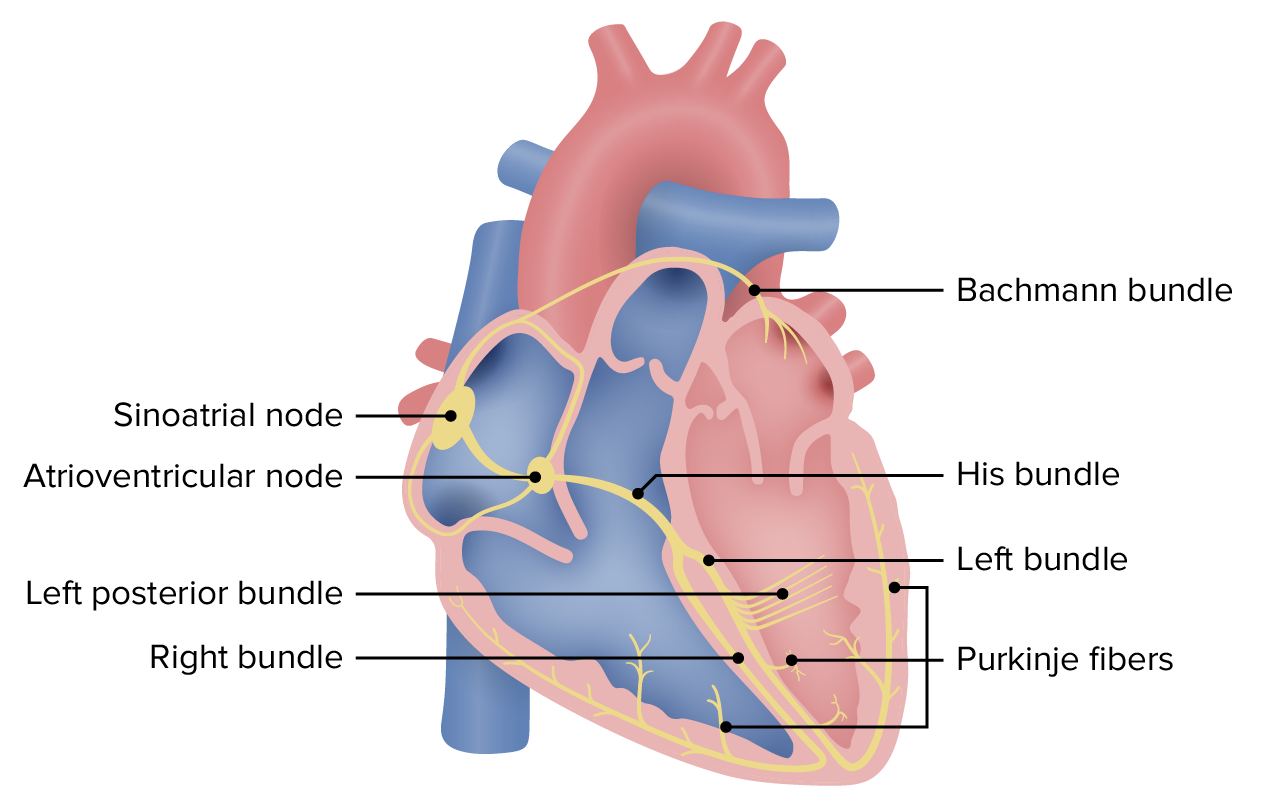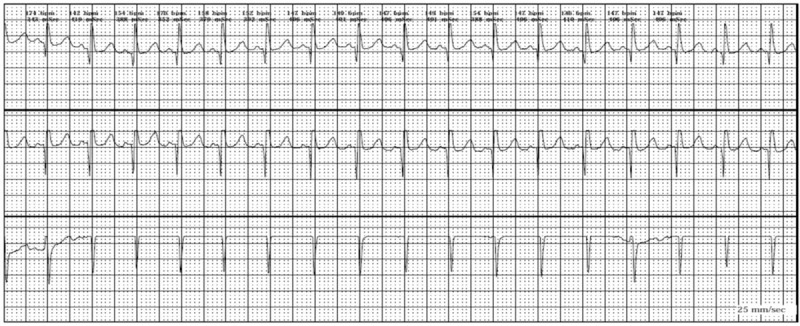Playlist
Show Playlist
Hide Playlist
Supraventricular Arrhythmias: Introduction
-
Slides Supraventricular Arrhythmias.pdf
-
Download Lecture Overview
00:01 Welcome back to the EKG lecture series. 00:04 Today, we're going to be speaking about supraventricular arrhythmias. 00:07 So, for example, a rapid heart rate greater than a hundred beats per minute with a sinus node appearing regular is called sinus tachycardia. 00:17 And a normal P-wave in front of each QRS with a heart rate less than 60, is called sinus bradycardia. 00:26 Here in the little table, sinus tachycardia: increased heart rate above 100. 00:32 Sinus bradycardia: decreased heart rate below 60. So, these sinus arrhythmias are normal. 00:40 They happen every day in healthy individuals. 00:43 For example, if you exercise, you go out to run or you get on the treadmill and/or or you're in the rowing machine. 00:51 Your body responds by increasing the heart rate because it's increasing the cardiac output to increase blood flow to the muscles. 00:59 So, your heart rate goes over 100, it's perfectly normal that's what happens with exercise. 01:04 Sometimes if you get excited because you're seeing an exciting sports event. 01:10 Or you wake up from a nightmare, you're gonna have sinus tachycardia. 01:14 But normally during sleep, the heart slows down because you don't need to pump as much blood to the resting muscles and often, the heart rate is less than 60. 01:23 In other words, sinus bradycardia. 01:26 So, excitement or exercise can cause sinus tachycardia. 01:30 Sinus bradycardia, for example during sleep. 01:33 And both are normal and are frequently present in healthy individuals depending upon the situation. 01:40 Sleep, exercise, excitement and so forth. 01:43 So, here's an example of a rhythm strip from a patient who was exercising vigorously. 01:50 And the heart rate is 135-140 per minute. 01:55 And you can calculate that if you want by calculating the big boxes and dividing into 300, it's almost 150, a little less. 02:04 And therefore, this is a 135-140. Normal sinus tachycardia in an individual exercising vigorously. 02:13 Here is an example of sinus bradycardia. 02:17 And this is occurring in a patient who's in deep sleep and the heart rate is 43 per minute. 02:24 Notice there's a P-wave in front of each QRS. The QRSs occur normally. 02:29 Look at the bottom strip that's the rhythm strip. 02:31 You'll notice PQRS, PQRS, normal relationship of P to QRS, just a very slow heart rate. 02:38 Normal in deep sleep. So supraventricular arrhythmias as I mentioned right at the beginning occur above the AV node. 02:48 They occur in the atria or sometimes they involve the earliest part of the AV node. 02:55 But in any case, you're still in the atrial area. 02:58 And the QRS is usually narrow because it's a beat arising from up top. 03:05 Remember in the lecture on heart block, when you use a subsidiary pacemaker down in the ventricle, the QRS was wide. 03:13 But where you're dealing with arrhythmias from above, the QRS is usually narrow unless the patient has a pre-existing bundle branch block, for example, they had a right bundle before they developed this. 03:25 Or sometimes the heart rate goes so fast with the supraventricular, then you may induce a so-called rate related right bundle which disappears when the heart rate slows down. 03:36 And that's what is pointed out here. 03:39 A fast - very fast heart rate can result in fatigue of the right bundle and this leads to a right bundle branch block pattern that occurs during the tachycardia. 03:48 But once the heart rate slows down, you go back to the normal and narrow QRS. 03:54 This happens sometimes in an arrhythmia which we're going to see in this lecture called atrial fibrillation and we'll show you some examples.
About the Lecture
The lecture Supraventricular Arrhythmias: Introduction by Joseph Alpert, MD is from the course Electrocardiogram (ECG) Interpretation. It contains the following chapters:
- Supraventricular Arrhythmias: Introduction
- Sinus Tachycardia
- Sinus Bradycardia
Included Quiz Questions
Which of the following statements is true?
- Sinus tachycardia typically has a normal QRS complex.
- Sinus bradycardia typically has a wide QRS complex.
- Sinus tachycardia is characterized by a heart rate slower than 100 beats/minute.
- Sinus bradycardia is characterized by a heart rate between 60 beats/minute and 70 beats/minute.
- Sinus tachycardia is an unusual finding during an untreated infection.
Where do supraventricular arrhythmias occur?
- Above or in the earliest part of the AV node
- In the AV node
- Above or in the bundle of His
- Above or in the left or right bundle branches
- Above or in the ventricles
Customer reviews
5,0 of 5 stars
| 5 Stars |
|
5 |
| 4 Stars |
|
0 |
| 3 Stars |
|
0 |
| 2 Stars |
|
0 |
| 1 Star |
|
0 |





